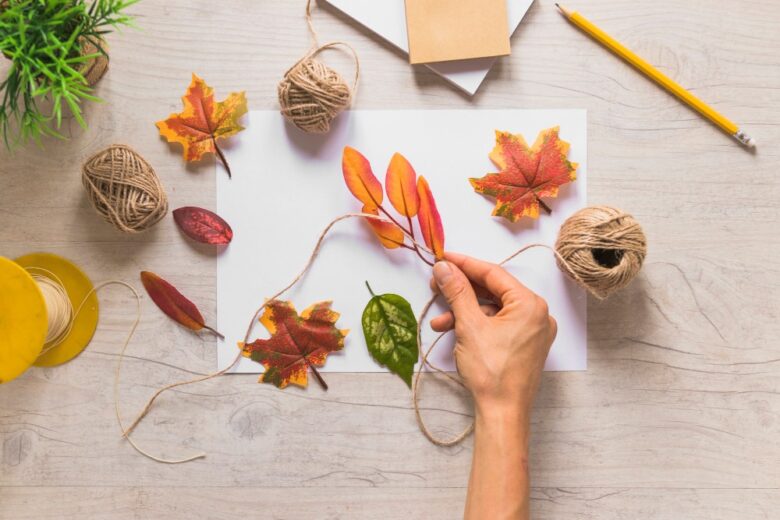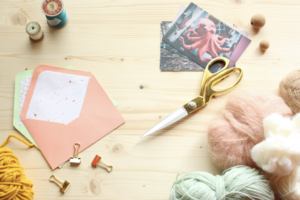To stay healthy and creative in the busy world we live in, it’s important to find ways to express yourself and be creative. As a hobby, crafting can help you relax and feel good while letting your artistic side shine. Anyone who wants hands-on creative experience is welcome in the production world, no matter how experienced he or she is. This article discusses the many benefits of making as a hobby and how it can help you relax and learn more about yourself.
1. The Pleasure of Making:
Making things is what crafting is all about, and there is no greater joy than making something yourself. Whether you’re making a simple piece of jewellery, a yarn scarf, or a card by hand, crafting can transform basic materials into something useful and visible. This feeling of success makes you feel good about yourself and makes you think positively.
When you do something creative, it also releases the neurotransmitter dopamine, which is associated with happiness and reward. The real and lasting feeling of happiness you get when you complete craft work is priceless.
2. Eliminate Stress and Relax:
In a world full of constant demands and pressure, taking time out to craft can be a relaxing escape. Many craft activities, such as knitting and crocheting, can put you in a mindful state because they are rhythmic and repetitive. This can help you relax and reduce stress.
Crafting allows people to focus on the task at hand, which can be soothing and meditative. Being mindful not only reduces stress but also makes you feel better mentally.
3. Personalized Home Decor:
Craftsmanship gives you the opportunity to make your living space more personal and stylish. You can ensure that your living space reflects your creativity and personality by creating personalised home décor items such as candles, cushions or wall art.
Making your own decorations is not only a great way to save money; it’s also fun. Each piece tells a story, making your home unique and welcoming.
4. Get to Know People:
Crafting is a hobby that you can do alone or together with others. Joining a craft group or going to a local craft workshop is a fun way to meet new people and make connections. Production groups allow people to share ideas, learn new skills, and connect with like-minded people.
Craft groups such as knitting circles, scrapbook clubs and pottery classes bring together people who love the same things and help each other. This creates a helpful and encouraging community in which friendships can develop.
5. Improve Skills:
Crafting consists of many different tasks, all of which are an opportunity to improve your skills. Whether you want to learn origami or paint with watercolours, doing different craft projects will help you learn new things and keep your mind sharp.
Crafting keeps the brain busy and interested because it requires constant learning. The process of learning and improving your craft skills can help you grow, whether you’re improving your sewing skills or trying a new painting style.
6. Sustainable and Environmentally Friendly:
At a time when sustainability is becoming increasingly important, crafting allows people to make things that have a lower impact on the world. A more sustainable lifestyle includes reusing materials, upcycling old items and using eco-friendly craft tools.
Craftsmanship emphasises that handmade, sustainable items are more valuable than mass-produced items, making people more conscious of how much they consume. By using environmentally friendly production methods, people can express their creativity while helping protect the planet.
7. Thoughtful Gifts:
Giving a homemade gift is a personal and sincere way to express your feelings. Crafts allow you to give gifts with a personal touch, such as a hand-knit blanket you made for a friend, jewellery you made especially for your loved one, or a card you made for a special event.
People often prefer handmade gifts because they are unique and show that a lot of effort goes into making them. Making something by hand and giving it as a gift can strengthen the personal bond and add more value to relationships.
Conclusion:
For many people, crafting is more than just making things. It’s a way to relax, learn more about yourself and feel fulfilled. The benefits of handicraft are not only in the end result; it’s also good for your mental health, social life and the environment.
Crafts offer you many ways to express your creativity, whether you prefer the precision of papermaking, the feel of woodworking or the refined details of embroidery. Crafting reminds us to slow down, enjoy making things, and nourish the artist within us in a world that sometimes seems too fast.
Crafting can help you express your creativity and take you on a journey of self-discovery that goes far beyond the craft table. Handmade is for anyone who wants to add beauty to their lives through handmade items, whether it’s creating useful household items or art that speaks to them. So grab these art supplies, let your mind wander and watch your ideas become true works of art.
FAQs:
1. What types of crafts are suitable for beginners who want to use their hands as a hobby?
Beginners can explore a variety of crafts, such as knitting, crocheting, paper crafts, and simple DIY home decor projects. Starting with simple and fun projects can build confidence and pave the way to more complex crafts.
2. How can crafts help relieve stress and relax?
Engaging in craft activities promotes a state of mindfulness, allowing individuals to focus on the present moment. The rhythmic and repetitive movements common to many crafts have a calming effect, reducing stress levels and promoting relaxation.
3. Can crafts be a social activity? How do I get in touch with other hobbyists?
Absolute! Handmade items can be enjoyed alone or together. Joining a local craft group, attending a workshop, or participating in an online craft community is a great way to connect with other crafters, exchange ideas, and build a support network.
4. What are some sustainable craft practices? How do you make environmentally friendly handicrafts?
Sustainable craftsmanship involves reusing materials, upcycling old objects and using environmentally friendly materials. Incorporating these practices into your craft projects can help lead to a more sustainable lifestyle that reduces your impact on the environment.
5. How does crafting help with skill development? What types of skills can I learn through crafting?
Crafts offer a variety of activities that promote skill development. From learning specific craft techniques to improving problem solving and creativity, working in a variety of crafts supports personal growth and continuous learning.


